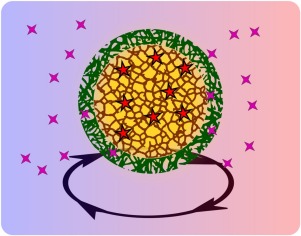当前位置:
X-MOL 学术
›
Colloids Surf. B Biointerfaces
›
论文详情
Our official English website, www.x-mol.net, welcomes your feedback! (Note: you will need to create a separate account there.)
Biodegradation model of porous silicon nanoparticles.
Colloids and Surfaces B: Biointerfaces ( IF 5.8 ) Pub Date : 2020-03-05 , DOI: 10.1016/j.colsurfb.2020.110946 M B Gongalsky 1 , A P Sviridov 1 , Yu I Bezsudnova 1 , L A Osminkina 1
Colloids and Surfaces B: Biointerfaces ( IF 5.8 ) Pub Date : 2020-03-05 , DOI: 10.1016/j.colsurfb.2020.110946 M B Gongalsky 1 , A P Sviridov 1 , Yu I Bezsudnova 1 , L A Osminkina 1
Affiliation

|
Development of porous silicon-based drug delivery systems for theranostics requires a precise control of their biodegradation. Thus, we propose a model for the biodegradation of porous silicon nanoparticles (PSi NPs) based on a diffusion equation combined with Nernst-Brunner mass transfer equation describing the dissolution of silicon and formation of silicic acid (SA). The spatiotemporal distributions of PSi NP porosity and SA concentration were calculated. The model was successfully applied to fitting a great variety of experimental data on more than 10 factors influencing the PSi NP biodegradation kinetics, such as the morphology of PSi NPs, surface composition, properties of surrounding media and protective coating layer. Two principal regimes were found out for systems with either diffusion or dissolution dominating over each other. The results of simulations revealed the values of several important parameters, which are hard to be measured experimentally.
中文翻译:

多孔硅纳米粒子的生物降解模型。
用于治疗学的基于多孔硅的药物输送系统的开发需要对其生物降解的精确控制。因此,我们基于扩散方程与描述硅的溶解和硅酸(SA)形成的Nernst-Brunner传质方程相结合,提出了多孔硅纳米颗粒(PSi NPs)生物降解的模型。计算了PSi NP孔隙度和SA浓度的时空分布。该模型已成功应用于对10多种影响PSi NP生物降解动力学的因素进行拟合的各种实验数据,例如PSi NP的形态,表面组成,周围介质和保护涂层的性能。对于以扩散或溶解为主的系统,发现了两个主要机制。
更新日期:2020-03-05
中文翻译:

多孔硅纳米粒子的生物降解模型。
用于治疗学的基于多孔硅的药物输送系统的开发需要对其生物降解的精确控制。因此,我们基于扩散方程与描述硅的溶解和硅酸(SA)形成的Nernst-Brunner传质方程相结合,提出了多孔硅纳米颗粒(PSi NPs)生物降解的模型。计算了PSi NP孔隙度和SA浓度的时空分布。该模型已成功应用于对10多种影响PSi NP生物降解动力学的因素进行拟合的各种实验数据,例如PSi NP的形态,表面组成,周围介质和保护涂层的性能。对于以扩散或溶解为主的系统,发现了两个主要机制。



























 京公网安备 11010802027423号
京公网安备 11010802027423号